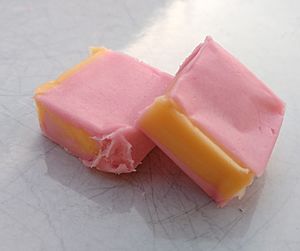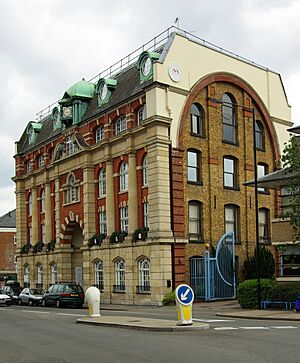Barratt (confectionery) facts for kids
Barratt is a famous brand of sweets in the United Kingdom. They are well-known for tasty treats like DipDab, Refreshers, Sherbet Fountain, Fruit Salad, Black Jack, and Wham.
The company, Barratt & Co., started in London in 1848. It was founded by George Osborne Barratt. By 1906, it had grown to become the biggest sweet maker in the whole world!
Barratt became a limited company in 1909. Over the years, other companies bought it. Bassett's took over in 1966. Then Cadbury Schweppes bought it in 1989. Since 2008, it has been part of Tangerine Confectionery, which is now called Valeo Confectionery.
Contents
The Sweet History of Barratt
George Osborne Barratt began his sweet-making business in 1848. He started with just one person making sweets in London. His business quickly became very popular. He bought more buildings nearby to help it grow.
Mr. Barratt used to travel around London in his pony and trap. He delivered and showed off his delicious sweets. Later, his oldest son, George, took over these trips. Mr. Barratt then traveled across much of the country for 20 years.
One reason for the company's success was a sweet called 'stickjaw' toffee. People said it was made by accident, but children loved it!
Growing the Factory
The business soon became too big for its first location. So, it moved to a former piano factory in Wood Green, north of London. The first new building was ready in 1882.
By 1904, Barratt was using eight buildings. These covered almost 5 acres of land. There was a big fire in 1899 that destroyed five buildings, but they rebuilt quickly. Just two years later, about 2,000 people worked there. They made 350 tonnes of sweets every week! This made Barratts the largest sweet manufacturer in the world.
After George Osborne Barratt passed away in 1906, his oldest son, George William, became the chairman. In 1909, the company officially became a limited company.
George Osborne's youngest son, Albert, was chairman and managing director from 1911 to 1921. He was honored in 1922 for his public service.
Changes Over Time
Barratt & Co. Ltd. joined Bassett's in 1966. Then, Cadbury Schweppes bought Bassett's in 1989. Since 2008, Barratt has been part of the Tangerine Confectionery family. The Barratt brand was brought back into use in 2018.
The original Wood Green factory closed in 1980. Today, a place called The Chocolate Factory stands where the old sweet factory used to be.
You can find old photos, brochures, and letters from former employees. These are kept in the archives of the London Borough of Haringey at Bruce Castle Museum.
Looking After Staff
Barratt generally had good relationships with its workers. The company even had its own union for employees in the early 1890s. This union helped workers and offered benefits if they got sick.
Workers often showed how much they appreciated the company. For example, they celebrated George and Mrs. Barratt's 50th wedding anniversary in 1899. They also showed thanks for a fun trip to Southend in 1910.
In the 1930s, a social club opened for staff. It had a club room, snooker, darts, dancing, and a drama group. The company also provided a nurse and a doctor at the factory. They even had a foot doctor and a fully equipped dental center with a dentist visiting once a week.
Popular Barratt Sweets
In the early days, Barratt mostly made "boilings." These were hard sweets like butter, raspberry, and ginger toffees. Later, they added sweets like Almond Rock and Brandy Snaps.
One very talked-about sweet was Tichborne Rock. This was a pulled rock sweet that had the figure of Sir Roger Tichborne inside. Shops would display it with a sign saying, "Crack the rock where'er you will / You'll find Sir Roger in it still."
In the 1880s, new sweets appeared. These included Yankee Panky, which was a soft sweet wrapped in wax paper. This was a new idea for the sweet industry! Rose Pastilles and Refresher Sticks also came out then.
Two very famous sweets, Black Jack and Fruit Salad, first appeared in 1920. The well-known Sherbet Fountain followed in 1925. The sherbet came in a paper-wrapped tube. It had a liquorice "straw" sticking out of the top for dipping!
By the 1950s, Barratt made about 200 different kinds of sweets. These included Rock, Sweet Cigarettes, Sherbet Products, Liquorice, and Caramels & Toffees.
Today, the Barratt brand, now part of Tangerine Confectionery, still offers many favorites. These include DipDab, Refreshers, Nougat, Sherbet Fountain, Fruit Salad, Black Jack, Wham, Refreshers Softies, and Fruit Salad Softies. The modern Sherbet Fountain, updated in 2009, is still a popular choice.
See also



